Research on the Prediction of Concealed Uranium Deposits Using Geo-Electrochemical Integrated Technology in the Guangzitian Area, Northern Guangxi, China
Abstract
1. Introduction
2. Regional Geological Setting
3. Technical Principles, Methodology, Sampling, and Analysis
3.1. Technical Principles
3.2. Sample Collection and Analytical Testing
4. Research on the Effectiveness of Mineral Exploration
4.1. Anomaly Characteristics of the Known Profile
4.2. Geology-Geoelectric Prospecting Model
4.2.1. Indicators in Geological Exploration
4.2.2. Geo-Electrochemical Extraction and Measurement Markers of Soil Ionic Conductivity and Thermally Released Mercury
5. Research on Mineral Prospecting Prediction
5.1. Statistical Analysis of Parameters
5.2. Planar Anomaly Characteristics of Geoelectrochemical Extraction Elements
5.3. Abnormal Characteristics of Soil Ionic Conductivity and Thermally Released Soil Mercury
5.4. Target Area Delineation and Engineering Validation
5.4.1. Demarcation of the Target Area
5.4.2. Engineering Validation
6. Conclusions
Author Contributions
Funding
Institutional Review Board Statement
Informed Consent Statement
Data Availability Statement
Conflicts of Interest
References
- Xu, D.R.; Chi, G.X. Diversity of uranium deposits in China—An introduction to the special issue. Ore Geol. Rev. 2021, 129, 103944. [Google Scholar] [CrossRef]
- Xiao, W.; Fan, H.H. Genesis of the Guangzitian uranium—Tungsten deposit in northern Guangxi—Geochemical evidences from in-situ U-Pb dating of pitchblende and mineral geochemistry. Geol. Rev. 2022, 68, 831–844. [Google Scholar]
- Cheng, Q. Singularity theory and methods for mapping geochemical anomalies caused by buried sources and for predicting undiscovered mineral deposits in covered areas. J. Geochem. Explor. 2012, 122, 55–70. [Google Scholar] [CrossRef]
- Liang, M.; Gao, W. Soil geochemical characteristics and ore prospecting prediction in Gaojianzi area, northern Hebei province. Geoscience 2023, 37, 1567–1579. [Google Scholar]
- Liu, P.F.; Wen, M.L. The application of geo-electrochemical integrated technology to the prospecting in the Xiyi Pb-Zn deposit, Yunnan province. Geophys. Geochem. Explor. 2016, 40, 655–660. [Google Scholar]
- Liu, P.F.; Luo, X.R. Geo-electrochemical anomaly prospecting for uranium deposits in southeastern China. Appl. Geochem. 2018, 97, 226–237. [Google Scholar] [CrossRef]
- Qiu, W.; Luo, X.R. Comparative study between the geo-electrochemical method and other geo-chemical exploration methods. Gold Sci. Technol. 2011, 19, 7–11. [Google Scholar]
- Gao, Y.; Luo, X.R. Geo-electrochemical extraction method for concealed gold deposits prospecting in high-altitude permafrost regions: A case study from the Dagou area, Golmud, Qinghai province, China. Guilin Univ. Technol. 2017, 37, 274–279. [Google Scholar]
- Li, S.; Sun, B.B. 1:50 000 electro-geochemical survey in the Luokedun lead-zinc polymetallic deposit, Inner Mongolia. Geophys. Geochem. Explor. 2020, 44, 514–522. [Google Scholar]
- Kang, M.; Luo, X.R. Improvement and applied results of geoelectrical chemistry methods. Geol. Explor. 2003, 5, 63–66. [Google Scholar]
- Luo, X.R.; Yang, X. Research on the detection of concealed ore deposits via geo-electrochemical measurements and preliminary surveys for mineral exploration. Geol. Explor. 1989, 12, 43–51. [Google Scholar]
- Liu, P.F.; Luo, X.R. Main study progress and prospect of geo-electrochemistry technology in China. Met. Mine 2022, 11, 10–22. [Google Scholar]
- Hou, D.M.; Luo, X.R. A comparative study of the prospecting for hidden uranium deposits by applying geo-electrochemical method in China and Australia. Geol. Bull. China 2012, 31, 126–135. [Google Scholar]
- Man, R.H.; Luo, X.R. Application of the geo-electrochemical method on prospecting for concealed uranium deposits in the Dongsheng area of the Ordos Basin. Bull. Mineral. Petrol. Geochem. 2015, 34, 1007–1013. [Google Scholar]
- Huang, N.N. The Research of Using Geo-Eletrochemical Integration Technology to Concealed Uranium Deposits in Dachengliang Area of Inner Mongolia. Master’s Thesis, Guilin University of Technology, Guilin, China, April 2017. [Google Scholar]
- Wen, M.L.; Luo, X.R. Electro-geochemical method in search of concealed uranium deposits in a area of Jiangxi province. Mineral. Explor. 2011, 2, 404–408. [Google Scholar]
- Ouyang, F.; Luo, X.R. Characteristics of geo-electric extraction anomalies and prospecting prediction in Lejia survey area, Xiangshan orefield, Jiangxi province. Met. Mine 2022, 11, 154–166. [Google Scholar]
- Wen, X.Q.; Luo, X.R. New method study in search of uranium deposit. Guilin Univ. Technol. 2003, 1, 26–30. [Google Scholar]
- Zhang, J.; Wen, M.L. Prospecting prediction using geoelectric extraction in the periphery of the No.374 deposit in Rongshui, Guangxi. Geoscience 2024, 38, 214–223. [Google Scholar]
- Zhao, X.Y.; Ouyang, F. Application of geo-electrochemical methods to prospecting in the concealed uranium: A case study of Lujing area, Zhuguang. Met. Mine 2022, 11, 167–178. [Google Scholar]
- Tang, B. Research on Mineralization Mineralogical Characteristics and Metallogenic Mechanism of Guangzitian Deposits. Master’s Thesis, East China University of Technology, Nanchang, China, June 2017. [Google Scholar]
- He, Y.K.; Zhang, D.H. Fluid geochemistry and its mineralization significance of the uranium ore deposit in Quanzhou, Guangxi province. Geol. Explor. 2010, 46, 670–680. [Google Scholar]
- Zhang, L.; Wang, F.Y. Metallogenesis of uranium deposits in China: Perspectives from uraninite chemistry. Ore Geol. Rev. 2024, 173, 106251. [Google Scholar] [CrossRef]
- Xiao, W. Mineralization of Uranium Deposits in the Quanzhou Ore Field in Guangxi Province. Master’s Thesis, China University of Geosciences, Beijing, China, May 2015. [Google Scholar]
- Luo, X.R. The Mechanism of Electro-Geochemical Halo-Formation and the Application of Electrochemical Method to Exploration of Metallic Ore Deposits. Ph.D. Thesis, Hefei University of Technology, Hefei, China, May 2005. [Google Scholar]
- Liu, P.F.; Wen, M.L. Geo-electrochemical extraction technology test and the prospecting prediction in cold plateau area. Geol. China 2015, 42, 2000–2007. [Google Scholar]
- Luo, X.R. Research and application effectiveness of novel methods in concealed deposit exploration. Geol. Explor. 1995, 1, 44–49. [Google Scholar]
- Wen, M.L.; Ouyang, F. Anomaly characteristics, components of soil ionic conductivity and prospecting prediction of tin deposits in Pinggui area, Guangxi. Geol. Bull. China 2013, 32, 784–789. [Google Scholar]
- Hou, L.H.; Tan, K.R. Experimental study on soil ionic conductivity measurement in prospecting and exploration of in-situ leachable sandstone-type uranium deposits. Geotecton. Metallog. 2002, 4, 448–451. [Google Scholar]
- Luo, X.R.; Zhou, T.F. Ionic conductivity anomaly characteristics and ionic components of soil in gold deposits in the Daxin’anlin forest overburden region. Geol. Explor. 2005, 2, 46–50. [Google Scholar]
- Zheng, C.J.; Luo, X.R. Comparison of conventional-warming RHg mercury release of soil with ladder-warming RHg mercury release, and ore prediction in Jielagepu au deposit, southern Tibet. Mineral. Petrol. 2018, 38, 99–110. [Google Scholar]
- Wei, J.S. Application and discussion of geochemical mercury measurement methods. Geophys. Geochem. Explor. 1999, 1, 22–28. [Google Scholar]
- Su, H.Y.; Luo, X.R. Application of soil heat-released mercury survey in prospecting prediction of copper-nickel polymetallic deposits in western Mianluening, Shaanxi province. Min. Explor. 2021, 12, 338–347. [Google Scholar]
- Zhou, Z.Y.; Luo, X.R. Measurement of heat releasing hg of soil and prospecting prediction in Shilongshan polymetallic gold deposit, Luoning county of Henan province. Mineral. Petrol. 2018, 38, 49–58. [Google Scholar]
- Liu, P.F.; Luo, X.R. Retrospect and prospect for geo-electrochemical technology research in the past three decades of China. J. Guilin Univ. Technol. 2018, 38, 47–55. [Google Scholar]
- Tang, R.; Ouyang, F. The prediction of electrochemical prospecting in Youfang area of the Xiangshan orefield. Geophys. Geochem. Explor. 2021, 45, 1425–1438. [Google Scholar]
- Shi, Y.H.; Yang, Z.P. Determination of trace elements in electroadsorption mineral exploration foam plastic samples by ICP-MS. Spectrosc. Spectr. Anal. 2009, 29, 1687–1690. [Google Scholar]
- Wang, D. Study on Searching for Concealed Uranium Deposits by Geo-Electrochemical Survey in Lejia Area, Xiangshan, Jiangxi Province. Master’s Thesis, Guilin University of Technology, Guilin, China, March 2020. [Google Scholar]
- Lu, C.Y.; Ouyang, F. Application of geo-electrochemical extraction technology in Chuandong survey area of Zhugongtang lead-zinc mine in Guizhou [J/OL]. Min. Explor. 2024, 1–17. [Google Scholar]
- Chen, J.Y.; Bai, Q. Discussion on the prospecting directions of carbonaceous-siliceous-argillaceous type uranium deposit in Hongliuhe-Fangshankou area, Gansu. Uranium Geol. 2020, 36, 500–509. [Google Scholar]
- Zhong, F.J.; Pan, J.Y. Exploration targeting model for carbonaceous-siliceous-argillaceous (C-SA) type uranium deposits in China. Acta Mineral. Sin. 2015, 35 (Suppl. S1), 372–373. [Google Scholar]
- Fu, J.; Zhao, N.B. Indicator characteristics of elementary geochemistry and anomaly model for Chinese carbonaceous-siliceous-argillaceous rock type uranium deposit. Uranium Geol. 2014, 30, 298–304. [Google Scholar]
- Wen, M.L.; Luo, X.R. A study of the ore-prospecting work based on multiple geosciences information in the Jinchuan Cu-Ni deposit. Geol. China 2013, 40, 594–601. [Google Scholar]
- Fu, J.; Zhao, N.B. Characteristics of indicator elements combination and genesis of four types of uranium mineralization in China. Geophys. Geochem. Explor. 2015, 39, 217–221. [Google Scholar]
- Song, H.; Xu, Z.Q. Geochemistry and LA-ICP-MS zircon U-Pb geochronological dating of diabase dykes and their relationship with mineralization of the carbonate-siliceous-pelitic rock type uranium deposits in Daxin-Qinjia, western Guangxi. Acta Petrol. Sin. 2019, 35, 2845–2863. [Google Scholar]
- Ye, Y.Q.; Chen, Y.L. Vertical zoning characteristics of trace element in gangue mineral of uranium deposit 510-1 in Zoige. Uranium Geol. 2015, 31, 510–516. [Google Scholar]
- Fu, J.; Zhao, N.B. Geochemical characteristics of uranium, thorium and potassium anomalies in China in relation to uranium mineralization. Geophys. Geochem. Explor. 2014, 38, 200–204. [Google Scholar]
- Fu, J.; Zhao, N.B. Geochemical anomaly characteristics of molybdenum in China and their indicative role for uranium mineralization. In Proceedings of the 2013 Annual Academic Conference of the Chinese Nuclear Society, Harbin, China, 11 September 2013. [Google Scholar]
- Zhao, N.B.; Fu, J. Study on the anomaly extraction of soil metal active state in sandstone type uranium deposit. Bull. Sci. Technol. 2019, 35, 33–39. [Google Scholar]
- Zou, D.F.; Yao, T. Experimental study on the application of soil thermorelease mercury methodin a gold mine area of Jiangxi province. World Nonferr. Met. 2020, 18, 65–67. [Google Scholar]

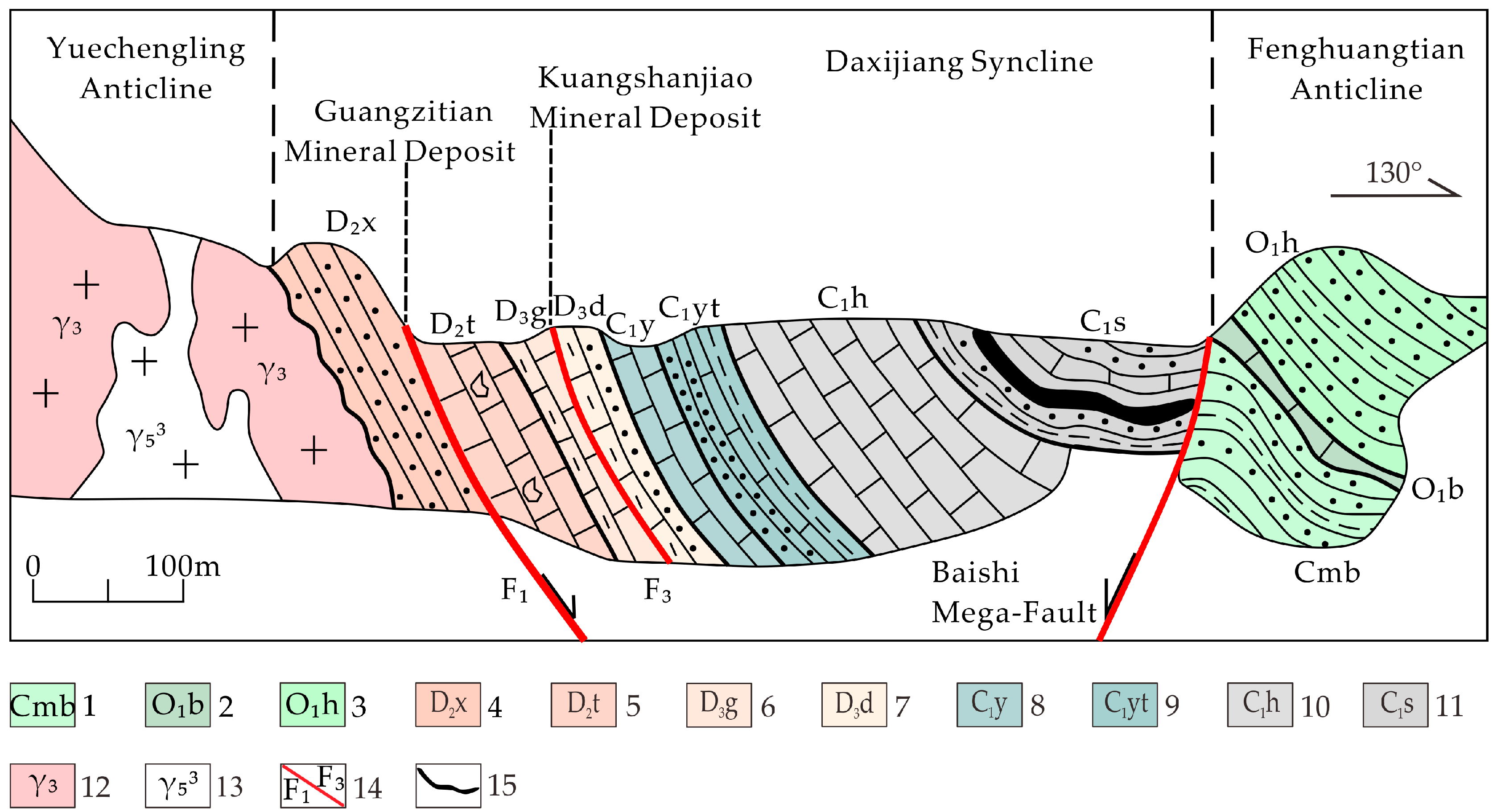

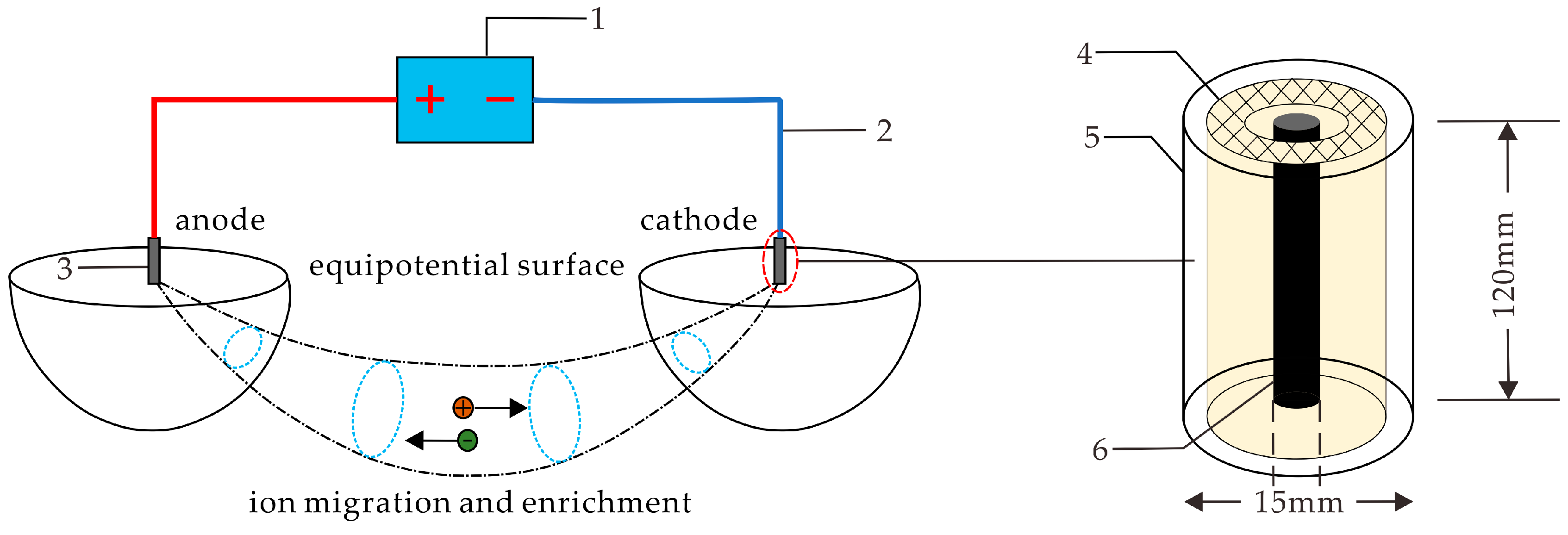
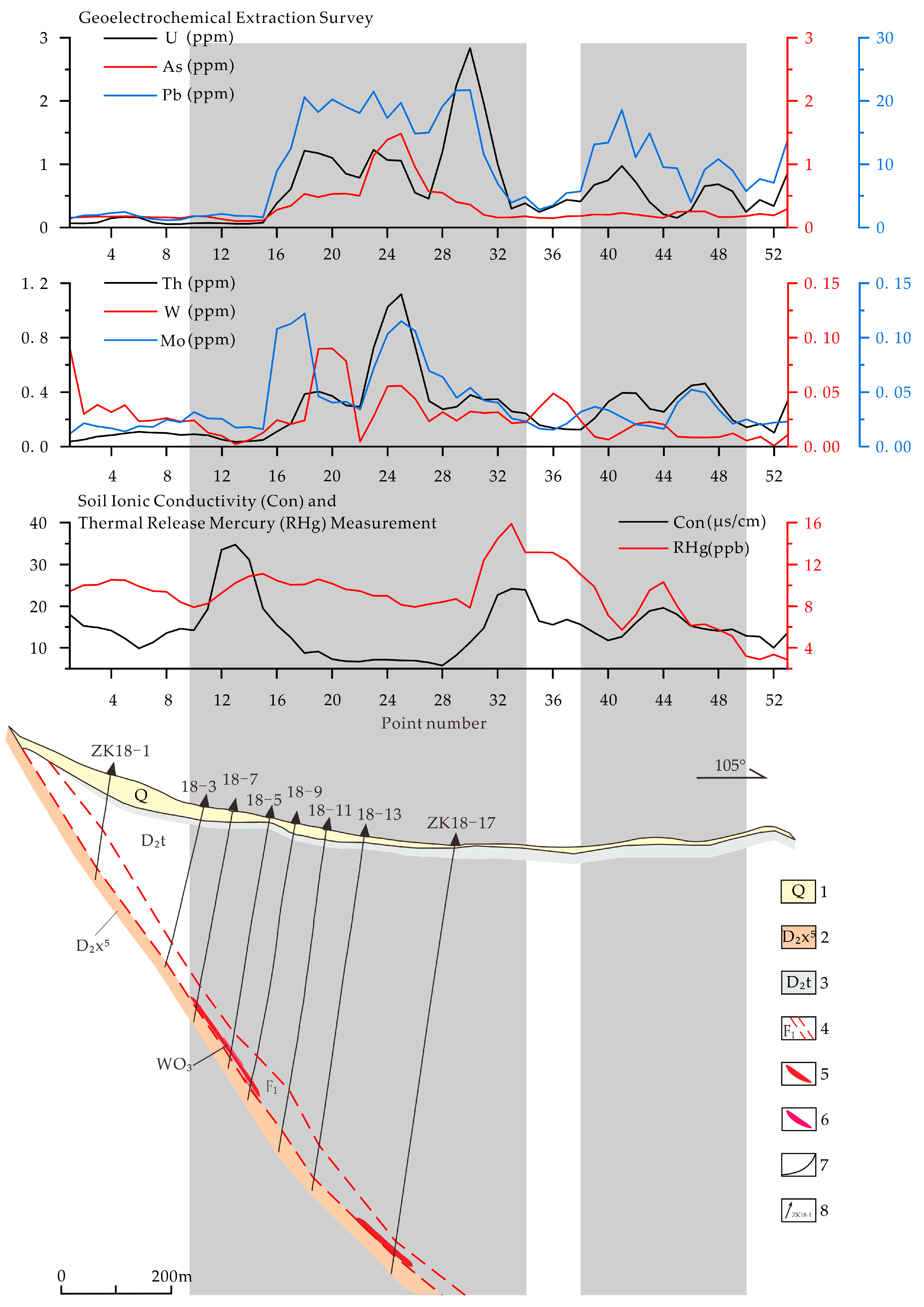
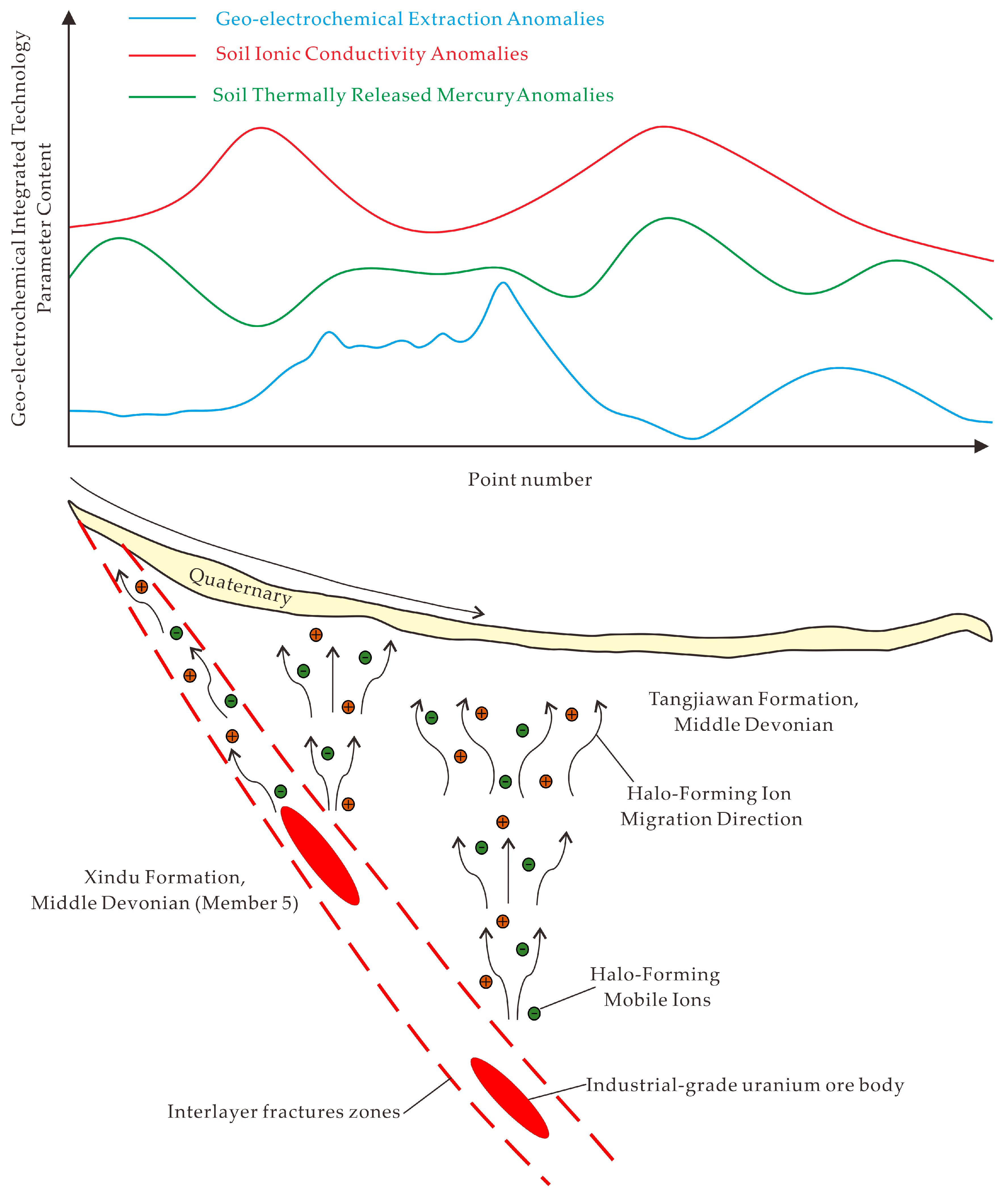



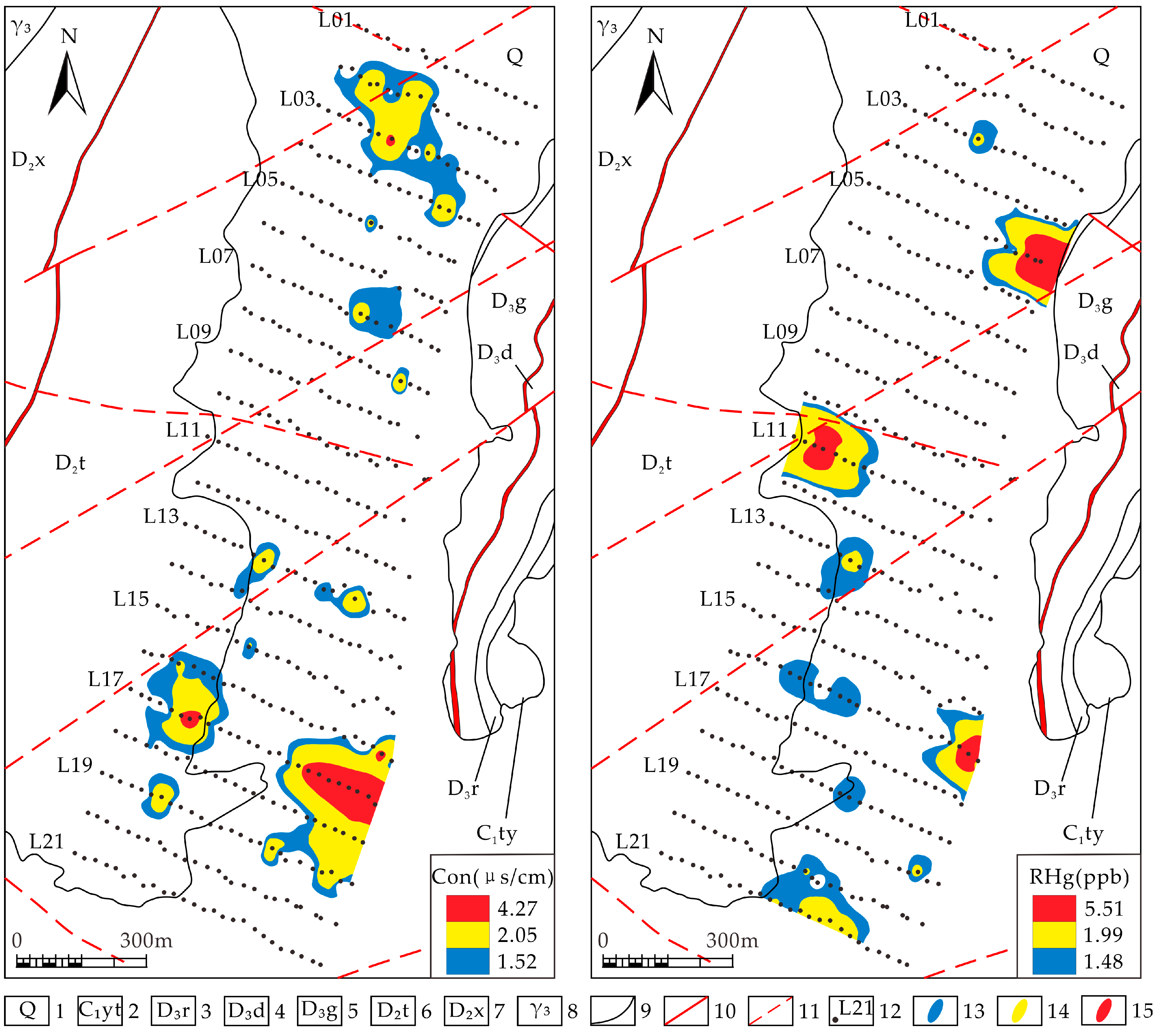



| Element | Detection Limit (μg/g) | Element | Detection Limit (μg/g) |
|---|---|---|---|
| U | 0.0065 | Mo | 0.0048 |
| Th | 0.1670 | As | 0.0717 |
| W | 0.0498 | Pb | 0.8620 |
| Data Category | Parameters | U | Th | W | Mo | As | Pb |
|---|---|---|---|---|---|---|---|
| Original data | Sample Size N1 | 462 | 462 | 462 | 462 | 462 | 462 |
| Maximum | 6.72 | 11.72 | 0.56 | 0.60 | 10.58 | 82.47 | |
| Minimum | 0.02 | 0.02 | 0.01 | 0.01 | 0.01 | 0.91 | |
| Average | 0.89 | 0.76 | 0.07 | 0.05 | 0.60 | 11.58 | |
| Standard Deviation | 1.24 | 1.21 | 0.06 | 0.06 | 0.83 | 13.53 | |
| Skewness | 2.55 | 4.74 | 4.57 | 4.52 | 4.89 | 1.89 | |
| Kurtosis | 6.66 | 30.54 | 28.99 | 30.18 | 46.90 | 3.40 | |
| Coefficient of Variation CV1 | 1.39 | 1.59 | 0.85 | 1.17 | 1.38 | 1.17 | |
| Eliminate the data with exceptional values | Sample Size N2 | 393 | 405 | 441 | 433 | 378 | 338 |
| Average | 0.45 | 0.43 | 0.06 | 0.04 | 0.30 | 4.65 | |
| Standard Deviation | 0.39 | 0.36 | 0.03 | 0.03 | 0.24 | 2.82 | |
| Coefficient of Variation CV2 | 0.87 | 0.83 | 0.47 | 0.74 | 0.82 | 0.61 | |
| CV1/CV2 | 1.60 | 1.92 | 1.81 | 1.58 | 1.68 | 1.92 | |
| Element | Original Data | Data After Partition Processing | ||||||||||
| Maximum | Minimum | Average | 85% | 92% | 98% | Maximum | Minimum | Average | 85% | 92% | 98% | |
| U | 6.72 | 0.03 | 0.89 | 1.59 | 2.16 | 3.12 | 31.74 | 0.10 | 2.96 | 5.43 | 7.42 | 10.13 |
| Th | 11.72 | 0.03 | 0.76 | 1.42 | 1.99 | 3.30 | 36.52 | 0.05 | 1.86 | 3.34 | 4.64 | 6.93 |
| W | 0.56 | 0.00 | 0.07 | 0.09 | 0.10 | 0.18 | 10.83 | 0.02 | 1.22 | 1.52 | 1.85 | 3.31 |
| Mo | 0.60 | 0.01 | 0.05 | 0.08 | 0.10 | 0.14 | 17.71 | 0.14 | 1.47 | 2.06 | 2.54 | 3.77 |
| As | 10.58 | 0.00 | 0.60 | 1.09 | 1.51 | 1.96 | 37.32 | 0.04 | 1.77 | 2.82 | 3.67 | 6.37 |
| Pb | 82.48 | 0.92 | 11.58 | 20.92 | 27.14 | 34.92 | 16.75 | 0.08 | 1.60 | 2.54 | 3.24 | 5.20 |
| Parameter | ZK192-11 | ZK190-7 | ZK192-1 | ZK192-17 |
|---|---|---|---|---|
| Elevation (m) | 258.10 | 246.65 | 231.44 | 228.32 |
| Drilling Depth (m) | 458.92 | 514.68 | 643.87 | 781.45 |
| Initial Borehole Inclination (°) | 85.7 | 81.4 | 82.4 | 81.8 |
| Depth of Ore Encounter (m) | 442.08 | 498.89 | 636.71 | 360.80 |
| True Thickness of Ore Body (m) | 6.73 | 9.17 | 0.81 | 9.96 |
| Ore Body Grade Range (%) | 0.05–1.32 | |||
| Average Ore Body Grade (%) | 0.186 | |||
Disclaimer/Publisher’s Note: The statements, opinions and data contained in all publications are solely those of the individual author(s) and contributor(s) and not of MDPI and/or the editor(s). MDPI and/or the editor(s) disclaim responsibility for any injury to people or property resulting from any ideas, methods, instructions or products referred to in the content. |
© 2025 by the authors. Licensee MDPI, Basel, Switzerland. This article is an open access article distributed under the terms and conditions of the Creative Commons Attribution (CC BY) license (https://creativecommons.org/licenses/by/4.0/).
Share and Cite
Zhang, X.; Wen, M.; Luo, Q.; Ma, Y.; Jiang, Y.; Jiang, Y.; Ye, W.; Zhang, J. Research on the Prediction of Concealed Uranium Deposits Using Geo-Electrochemical Integrated Technology in the Guangzitian Area, Northern Guangxi, China. Appl. Sci. 2025, 15, 7426. https://doi.org/10.3390/app15137426
Zhang X, Wen M, Luo Q, Ma Y, Jiang Y, Jiang Y, Ye W, Zhang J. Research on the Prediction of Concealed Uranium Deposits Using Geo-Electrochemical Integrated Technology in the Guangzitian Area, Northern Guangxi, China. Applied Sciences. 2025; 15(13):7426. https://doi.org/10.3390/app15137426
Chicago/Turabian StyleZhang, Xiaohan, Meilan Wen, Qiaohua Luo, Yunxue Ma, Yuheng Jiang, Yuxiong Jiang, Wei Ye, and Jiali Zhang. 2025. "Research on the Prediction of Concealed Uranium Deposits Using Geo-Electrochemical Integrated Technology in the Guangzitian Area, Northern Guangxi, China" Applied Sciences 15, no. 13: 7426. https://doi.org/10.3390/app15137426
APA StyleZhang, X., Wen, M., Luo, Q., Ma, Y., Jiang, Y., Jiang, Y., Ye, W., & Zhang, J. (2025). Research on the Prediction of Concealed Uranium Deposits Using Geo-Electrochemical Integrated Technology in the Guangzitian Area, Northern Guangxi, China. Applied Sciences, 15(13), 7426. https://doi.org/10.3390/app15137426





